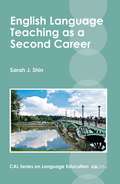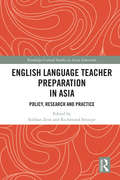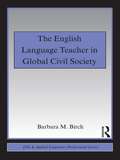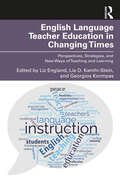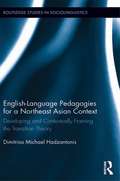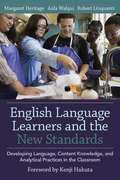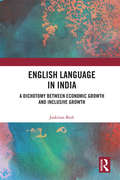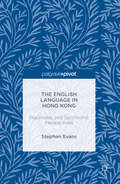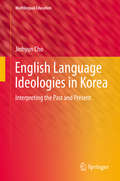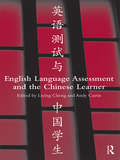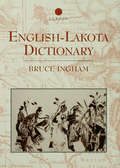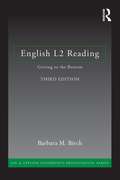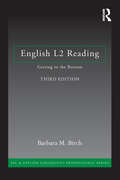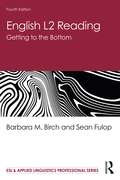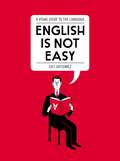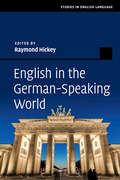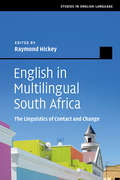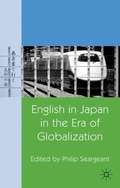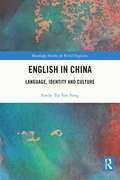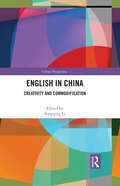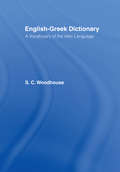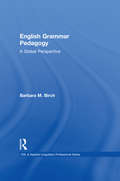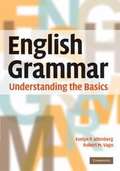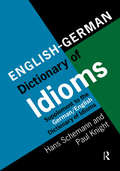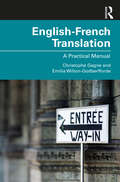- Table View
- List View
English Language Teaching as a Second Career
by Sarah J. ShinThis book explores the experiences of men and women who train to teach ESL as a second career. Drawing from in-depth interviews and observations of 30 students (aged 45 to 73) in a TESOL graduate program, this book provides portraits of these individuals as they develop as teachers. It describes the processes they go through to launch their teaching careers, the successes and challenges they face, and the evolving significance of their work in their overall life goals and achievements. A welcome addition to the growing literature on teacher development, this book will be an important resource for teacher trainers and anyone working in TESOL.
English Language Teacher Preparation in Asia: Policy, Research and Practice (Routledge Critical Studies in Asian Education)
by Subhan Zein Richmond StroupeBringing together a comprehensive range of extended research-based chapters, English Language Teacher Preparation in Asia provides comprehensive insight into policy, research, and practical aspects of teacher preparation for English teachers at pre-service level across multiple contexts in Asia. Written by local and international scholars specialising in TESOL Teacher education, and acknowledging the increasingly complex demands made on teachers of English in view of globalisation, the book explores the multiple factors which are key to effective professional learning. Chapters consider how pre-service teachers are best prepared for the diverse contexts in which English is learnt and taught in settings throughout Asia and draw on in-depth research studies to provide rich, fully contextualised coverage of aspects of teacher preparation including curriculum design, programme development, policy, professional learning communities, assessment education, and teaching practicum. A timely contribution to the field of teacher preparation, this text will be an invaluable resource for teacher educators, pre-service teachers and academics involved in the preparation of English teachers in Asia.
The English Language Teacher in Global Civil Society (ESL & Applied Linguistics Professional Series)
by Barbara M. BirchHow can English language teachers contribute to peace locally and globally? English language teachers and learners are located in the global civil society – an international network of civil organizations and NGOs related to human rights, the environment, and sustainable peace. English, with its special role as an international language, is a major tool for communication within this network. On the local level, many teachers are interested in promoting reconciliation and sustainable peace, but often do not know how to do so. This book provides information, analysis, and techniques to help teachers around the world take action toward this goal. Balancing, in a readable and accessible way, the global and the local, core and periphery, cultural diffusion and resistance, theory and practice, pessimism and optimism, outsider and insider perspectives, the expert role and the apprentice role, and prescriptive and elicitive methods, it offers an alternative to literature about critical applied linguistics, globalization, and peace education that is simply too complex and wordy to spread easily from theoretician to the classroom teacher. The English Teacher in Global Civil Society: synthesizes threads from many fields and topics into a coherent and empowering argument for the activist role English language teachers can take to promote social change draws on humanistic education, peace education, cross-cultural understanding, problem-posing, cooperative learning, and critical thinking methodologies to help English language teachers learn how to teach conflict resolution skills in their classrooms covers issues in critical applied linguistics, approaches and methodologies in ESL/EFL, global and local curricular issues, and specific skill areas such reading, writing, and speaking suggests a new goal for English language teachers: global citizenship. This engaging, informative, provocative, and highly readable book is a welcome resource for English language teacher trainers, pre-service teachers, practicing classroom teachers, and Peace Corps workers around the world.
English Language Teacher Education in Changing Times: Perspectives, Strategies, and New Ways of Teaching and Learning
by Liz England Lía D. Kamhi-Stein Georgios KormpasThis volume addresses challenges that the field of English language teacher education has faced in the past several years. The global pandemic has caused extreme stress and has also served as a catalyst for new ways of teaching, learning, and leading. Educators have relied on their creativity and resiliency to identify new and innovative teaching practices and insights that inform the profession going forward. Contributors describe how teacher educators have responded to the specific needs and difficulties of educating teachers and teaching second language learners in challenging circumstances around the world and how these innovations can transform education going forward into the future. Paving the way for a revitalized profession, this book is essential reading for the current and future generations of TESOL scholars, graduate students, and professors.
English Language Pedagogies for a Northeast Asian Context: Developing and Contextually Framing the Transition Theory (Routledge Studies in Sociolinguistics)
by Michael HadzantonisThis book investigates, from a sociocultural, linguistic, and pedagogical perspective, the conceptual and pragmatic frameworks that characterize secondary language learning in a Northeast Asian context. Hadzantonis contextualizes these salient domains through an engagement with social and cultural themes such as the familial, political, as well as cultural commodities and socioeducational structures. In this way, the text employs tools such as transnational theory and performativity and develops a model that contributes to the resolution of one of the greatest economic issues of the time, that of ineffective secondary language learning.
English Language Learners and the New Standards: Developing Language, Content Knowledge, and Analytical Practices in the Classroom
by Margaret Heritage Aída Walqui Robert LinquantiIn English Language Learners and the New Standards, three leading scholars present a clear vision and practical suggestions for helping teachers engage ELL students in simultaneously learning subject-area content, analytical practices, and language. This process requires three important shifts in our perspective on language and language learning—from an individual activity to a socially engaged activity; from a linear process aimed at correctness and fluency, to a developmental process, focused on comprehension and communication; and from a separate area of instruction to an approach that embeds language development in subject-area activities. In English Language Learners and the New Standards, the authors:Clarify the skills and knowledge teachers need to integrate content knowledge and language developmentShow how teachers can integrate formative assessment in ongoing teaching and learningDiscuss key leverage points and stress points in using interim and summative assessments with ELLsProvide classroom vignettes illustrating key practicesFinally, the authors explain the theories and research that underlie their vision and examine the role of policy in shaping pedagogy and assessment for ELL students.
English Language in India: A Dichotomy between Economic Growth and Inclusive Growth
by Jaskiran BediThis book examines the relationship between the English language and growth – economic and inclusive – in India. It explores why English continues to be the language of aspiration long after Independence. With the second largest English-speaking population in the world today, India is testimonial to how a linguistic legacy continues to cast a long shadow on its contemporary discourse in the economic arena. The volume: Explores how English language proficiency constitutes as human capital. Draws in the latest India Human Development Survey data. Investigates the relationship between the language and economic indicators such as wages, household income and state growth. Purther investigates the role of English language in the inclusivity of growth. Provides a snapshot of the pedagogy of English in the Indian education system. First of its kind in scope, this volume will be of great interest to scholars of economics, education, sociolinguistics, development studies, politics and sociology. It will also be of great interest to the general reader.
The English Language in Hong Kong
by Stephen EvansThis book presents an empirically-grounded sociolinguistic history of the English language in Hong Kong in the past 170 years. Using substantial sets of diachronic and synchronic data, it traces the changing status and functions of English in relation to spoken Cantonese, Mandarin and written Chinese in the key domains of government, education and business. The author tracks the rise of English-knowing bilingualism in the city's Chinese community and explores the evolutionary dynamics of Hong Kong English. He also speculates on the future of English in the territory, particularly after 2047 when the 'one country, two systems' framework established by the Sino-British Joint Declaration is dismantled. Researchers and students working in the fields of sociolinguistics, English as a global language, world Englishes, applied linguistics and English-language education will find this book provides valuable information and insights about the uses and users of English in colonial and post-colonial Hong Kong. More generally, it makes a unique contribution to the literature on the diffusion and diversification of English worldwide.
English Language Ideologies in Korea
by Jinhyun ChoThis volume critically examines the phenomenon of "English fever" in South Korea from both micro- and macro-perspectives. Drawing on original research and rich illustrative examples, the book investigates two key questions: why is English so popular in Korea, and why is there such a gap between the 'dreams' and 'realities' associated with English in Korea? These questions are explored through the eyes of English-Korean translators and interpreters, who represent the professional group most intensely engaged in the zeal for English language mastery. Macro-perspectives focus on historical factors leading to the rise of English, with English-Korean translation and interpreting as a key theme. Micro-perspectives explore the dreams that individuals attach to English and the ways in which they imagine it can transform their lives, and contrast these dreams with the stark realities felt on the ground. The gaps between these dreams and realities are explored from various angles, which include commodification, gender and neoliberalism. The book thus offers fresh insights on how the phenomenon of "English fever" has been created, reproduced, and sustained from both historical and contemporary viewpoints.
English Language Assessment and the Chinese Learner
by Liying Cheng Andy Curtis'This volume addresses a very timely and important topic, and provides both broad and in-depth coverage of a number of large-scale English tests in China, including Hong Kong and Taiwan, and about the Chinese learner.' – Lyle F. Bachman, From the Foreword Building on current theoretical and practical frameworks for English language assessment and testing, this book presents a comprehensive, up-to-date, relevant picture of English language assessment for students in China (Mainland China, Hong Kong and Taiwan) and for Chinese learners of English around the world. Written by well-recognized international scholars in language testing, it covers: the history of tests and testing systems, issues and challenges, and current research in China both test-designers’ and test-users’ points of view on test development and test validation within a range of political, economical, social, and financial contexts in China theoretical/conceptual perspectives on the use of the English language assessment at different levels, including societal, university, and schools empirical research related specifically to test development, curricular innovation, and test validation Given the long history of objective testing and its extensive use in Chinese society, and considering the sheer number of students taking various tests in English in China and elsewhere, an understanding of the impact of English language testing is essential for anyone involved in testing and assessment issues in China and elsewhere in the world. This is a must-read volume for testing and assessment policy makers, curriculum designers, researchers, ESL/EFL materials writers, graduate students, and English language teachers/researchers at all levels.
English-Lakota Dictionary
by Bruce InghamThis dictionary of 12,000 entries aims to preserve Indian culture and at all points illustrate the use of words in examples, especially syntactic words, whose usage cannot be captured purely by giving an English equivalent. It provides depth as regards the usage of frequently occurring items and especially in the use of syntactic elements and usage in context.
English L2 Reading: Getting To The Bottom
by Barbara M. BirchEnglish L2 Reading, Third Edition offers teachers research-based insights into bottom-up skills in reading English as a second language and a solid foundation on which to build reading instruction. Core linguistic and psycholinguistic concepts are presented within the context of their application to teaching. The goal is to balance or supplement (not replace) top-down approaches and methodologies with effective low-level options for teaching English reading. The text's pedagogical features-- Questions, Study Guide Questions. Discussion Questions, Spotlight on Teaching sections-- engage readers of the text in moving easily from linguistic details and psycholinguistic data and theory to practical explanations and suggestions for teaching. Two Appendices provide tables that list the graphemes or the phonemes of English.
English L2 Reading: Getting to the Bottom
by Barbara M. BirchEnglish L2 Reading, Third Edition offers teachers research-based insights into bottom-up skills in reading English as a second language and a solid foundation on which to build reading instruction. Core linguistic and psycholinguistic concepts are presented within the context of their application to teaching. The goal is to balance or supplement (not replace) top-down approaches and methodologies with effective low-level options for teaching English reading. The text’s pedagogical features— Questions, Study Guide Questions. Discussion Questions, Spotlight on Teaching sections— engage readers of the text in moving easily from linguistic details and psycholinguistic data and theory to practical explanations and suggestions for teaching. Two Appendices provide tables that list the graphemes or the phonemes of English. Changes in the Third Edition Shift in focus from criticism of whole language methodologies to a more neutral stance —times have changed and the study of lower-level reading strategies is now mainstream Greater focus on linguistic form, along with function and meaning Updated information about reading strategies at each level of the reading process More Spotlight on Teaching sections, one for each chapter New chapter on spelling development
English L2 Reading: Getting to the Bottom (ESL & Applied Linguistics Professional Series)
by Barbara M. Birch Sean FulopEnglish L2 Reading: Getting to the Bottom uses research-based insights to examine bottom-up skills in reading English as a second language. This fourth edition clearly presents core concepts alongside their practical applications to teaching contexts, with updated research findings, a new focus on metalinguistic awareness, and new resources for students. The text’s pedagogical features help readers connect linguistic details and psycholinguistic theory with practical explanations and teaching suggestions. Pre-reading Questions challenge readers to analyze their own experiences. Study Guide Questions allow readers to review, discuss, and assess their knowledge. Discussion Questions elaborate on themes in each chapter, while the new Language Awareness Activities help develop metalinguistic awareness. Three Appendices provide tables that list the graphemes and the phonemes of English, as well as a brand-new dictionary pronunciation guide. New to the fourth edition: Substantially revised and updated research on linguistics New, evidence-based models on the reading process Language Awareness Activities that highlight metalinguistic awareness Word study examples in each chapter For teachers, teacher trainers, reading researchers, or anyone interested in teaching reading, this popular, comprehensive, myth-debunking text provides clear and practical guidance towards effectively supplementing top-down teaching approaches with bottom-up reading strategies.
English Is Not Easy: A Visual Guide to the Language
by Luci GutiérrezA cheeky, sophisticated, and strikingly illustrated guide that leaves generic English reference books in the dust When prominent Barcelona-based illustrator Luci Gutiérrez found herself tuning out in English class, she used her love of drawing to help retain what she’d learned. Ditching the kind of bland and useless phrases that fill most English textbooks, Gutiérrez uses whimsical characters, cheeky dialogue, and even insults to bring vocabulary, grammar, and usage topics to life. Nearly forty-seven million people in the United States speak a language other than English at home, and even most native speakers struggle with subtle distinctions, such as when to use “whether” as opposed to “if.” (For example: I wonder whether I should have added a little more poison to his tea.) Already published to wide acclaim abroad, English Is Not Easy is sure to delight grammar mavens and students of English in America.
English in the German-Speaking World (Studies in English Language)
by Raymond HickeyEnglish has a considerable history in Germany, Austria and Switzerland, and present-day English has a significant influence on the vocabulary of modern German. Examining the ongoing influence of English on German in these countries, Raymond Hickey leads a team of authors to explore a wide range of topics, such as the history of English teaching in Germany, the type of English spoken in German-speaking countries today, and the role of English in German society. Borrowings from English in present-day German, as well as the use of English in public places, is also discussed, as is the use of English by non-Germans living in Germany, and the situation of Germany as a country with English as a foreign language. Comparisons with other European countries are also analysed, and a consideration of the German-English interface in places as far apart as the United States and Namibia, is also presented.
English in Multilingual South Africa: The Linguistics of Contact and Change (Studies in English Language)
by Raymond HickeySouth Africa is a country characterised by great linguistic diversity. Large indigenous languages, such as isiZulu and isiXhosa, are spoken by many millions of people, as well as the languages with European roots, such as Afrikaans and English, which are spoken by several millions and used by many more in daily life. This situation provides a plethora of contact scenarios, all of which have resulted in language variation and change, and which forms the main focus of this insightful volume. Written by a team of leading scholars, it investigates a range of sociolinguistic factors and the challenges that South Africans face as a result of multilingualism and globalisation in both education and social interaction. The historical background to English in South Africa provides a framework within which the interfaces with other languages spoken in the country are scrutinised, whilst highlighting processes of contact, bilingualism, code-switching and language shift.
English in Japan in the Era of Globalization
by Philip SeargeantLeading scholars in the field examine the role played by the English language in contemporary Japanese society. Their various chapters cover the nature, status, and function of English in Japan, focusing on the ways in which globalization is influencing language practices in the country.
English in China: Language, Identity and Culture (Routledge Studies in World Englishes)
by Emily Tsz FongThis volume explores Chinese identity through the lens of both the Chinese and English languages. Until the twentieth century, English was a language associated with capitalists and "military aggressors" in China. However, the massive progression of globalisation in China following the 1980s has transformed the language into an important tool for China’s modernisation. Regardless of the role English plays in China, there has always been a fear there that the spread of culture(s) associated with English would lead to weakening of the Chinese identity. This fear resulted in the development of the ti-yong principle: "Chinese learning for essence (ti), Western learning for utility (yong)." Fong’s book aims to enhance understanding of the ti-yong dichotomy in relation to people’s sense of being Chinese in China, the penetration of English into non-English speaking societies, the resultant tensions in people’s sense of personal and national identity, and their place in the world. Using Q methodology, the book presents observations based on data collected from four participant groups, namely high school and university students, teachers and parents in China, to investigate their perspectives on the status and roles of English, as well as those of Chinese. Considering the growing international interest in China, this volume will appeal to readers interested in China’s contemporary society in general, its language, culture and identity. It will be a useful resource for academics, researchers and students in the field of applied linguistics, language education and Chinese cultural studies and can also be adopted as a reference book for undergraduate courses relating to language, identity and culture.
English in China: Creativity and Commodification (China Perspectives)
by Songqing LiEnglish-related linguistic creativity and language commodification are a constant topic of interest and analysis for scholars. This volume is intended to initiate a dialogue between these two domains of inquiry that have been abundantly addressed but rarely documented together or in relation to one another. English as used in mainland China is presented as a case study where it remains rather unclear the extent to which the language is actually used in people’s lives, outside the domain of education. The volume enriches existing empirical studies by exploring the creative and innovative uses of English in people’s lives and its commodification at different language-centred economic spaces within China while also providing an update of our understanding of the sociolinguistic situation of English in China, a country undergoing rapid socio-economic transformation. English in China is the first attempt to discuss the possible relationship, intersection, and tension between two seemingly inseparable research topics. The book is an important resource for students and scholars in the fields of Applied Linguistics, Bilingualism, Sociolinguistics, Translation, and Contemporary Chinese Studies.
English-Greek Dictionary: With a Supplement of Proper Names Including Greek Equivalents for Famous Names in Roman History
by S. C. WoodhouseFirst published in 1998. Routledge is an imprint of Taylor & Francis, an informa company.
English Grammar Pedagogy: A Global Perspective (ESL & Applied Linguistics Professional Series)
by Barbara M. BirchDesigned for ESL and ELT pedagogy courses around the world, this text describes English grammar from a World Englishes perspective. It is distinguished by its focus on the social setting for English as a global language, the latest thinking about grammatical theory, and new theories of how first and second languages are learned and taught. The fundamental premise is that teaching and learning grammar cannot be isolated from the local, regional, and global sociocultural contexts in which the teaching and learning take place. Part I presents different attitudes toward English as a global language and some challenges that learners of English share no matter where they are in the world. Part II is about the features of English that educated speakers consider the most likely and probable in Academic English. Part III describes the flexible and fluid features of English that might be susceptible to change or modification over time. Each chapter includes engaging Study, Discussion, and Essay Questions and Activities.
English Grammar
by Evelyn P. Altenberg Robert M. VagoLooking for an easy-to-use guide to English grammar? This handy introduction covers all the basics of the subject, using a simple and straightforward style. Students will find the book's step-by-step approach easy to follow and be encouraged by its non-technical language. Requiring no prior knowledge of English grammar, the information is presented in small steps, with objective techniques to help readers apply new concepts. With clear explanations and well chosen examples, the book gives students the tools to understand the mysteries of English grammar as well as the perfect foundation from which to move on to more advanced topics.
English/German Dictionary of Idioms: Supplement to the German/English Dictionary of Idioms
by Professor Hans SchemannThis dictionary is the ideal supplement to the German/English Dictionary of Idioms, which together give a rich source of material for the translator from and into each language. The dictionary contains 15,000 headwords, each entry supplying the German equivalents, variants, contexts and the degree of currency/rarity of the idiomatic expression. This dictionary will be an invaluable resource for students and professional literary translators.Not for sale in Germany, Austria or Switzerland
English-French Translation: A Practical Manual
by Christophe Gagne Emilia Wilton-GodberffordeEnglish-French Translation: A Practical Manual allows advanced learners of French to develop their translation and writing skills. This book provides a deeper understanding of French grammatical structures, the nuances of different styles and registers and helps increase knowledge of vocabulary and idiomatic language. The manual provides a wealth of practical tasks based around carefully selected extracts from the diverse text types students are likely to encounter, from literary and expository, to persuasive and journalistic. A mix of shorter targeted activities and lengthier translation pieces guides learners through the complexities and challenges of translation from English into French. This comprehensive manual is ideal for advanced undergraduate and postgraduate students in French language and translation.
